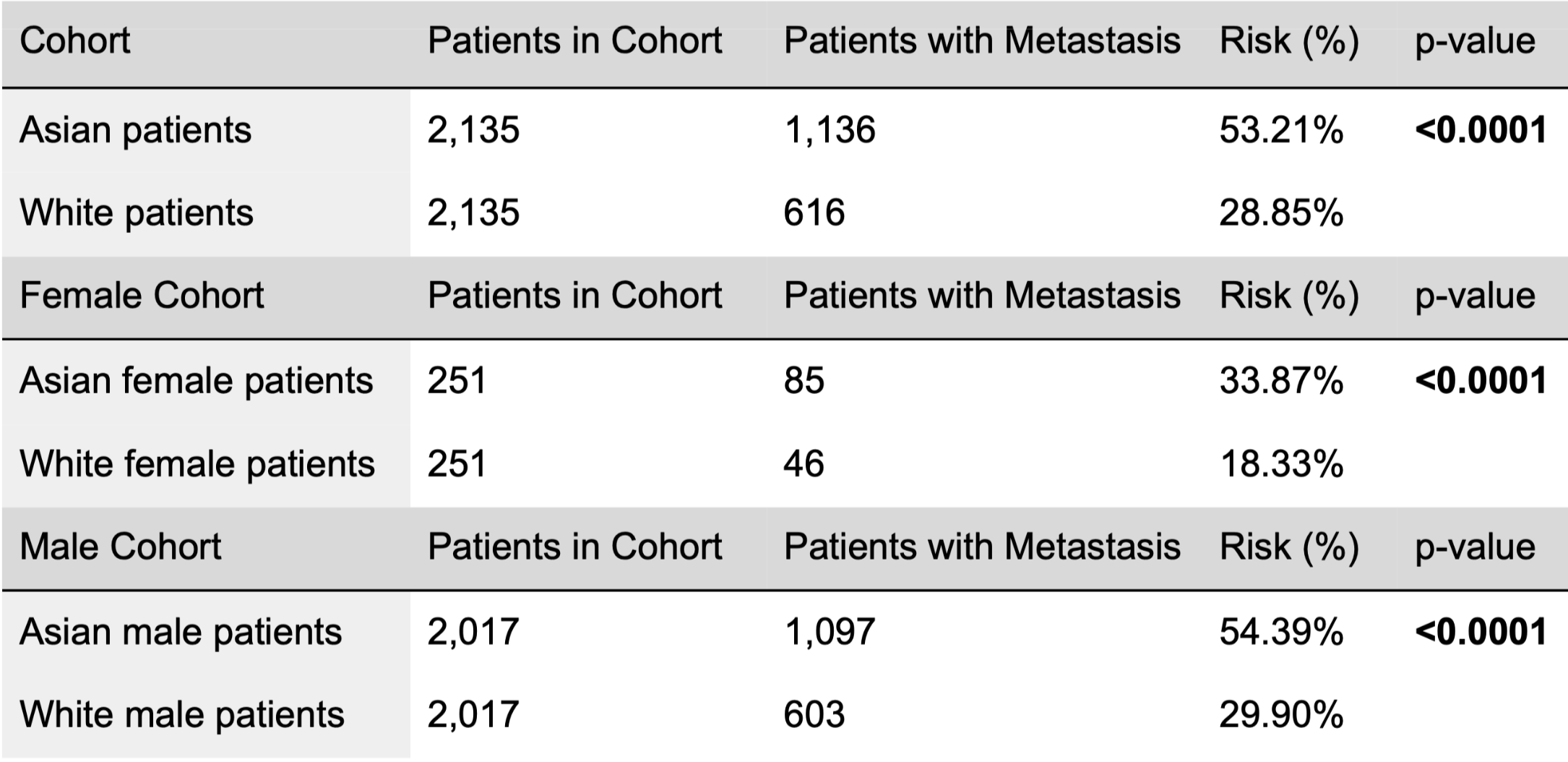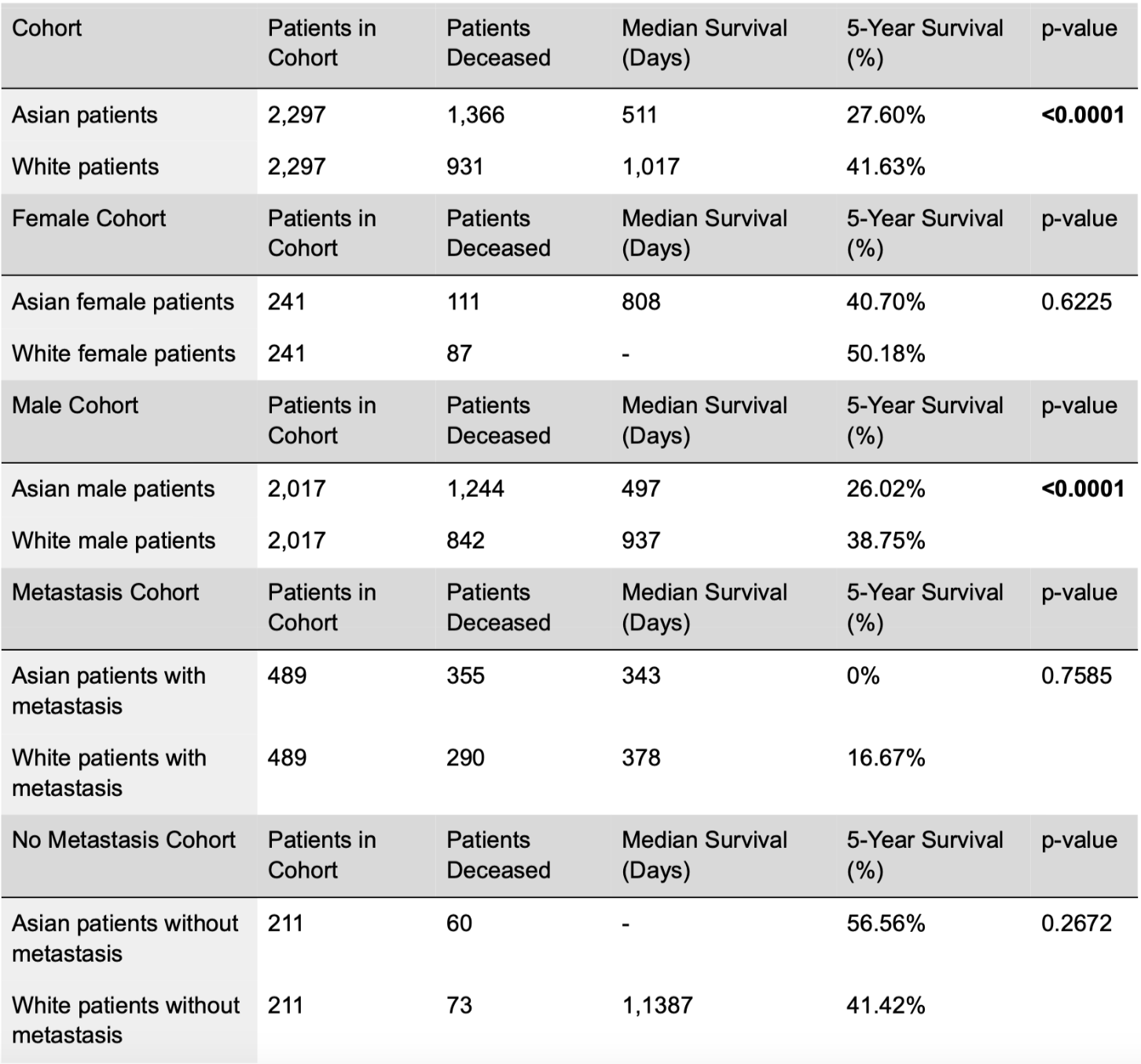Monday Poster Session
Category: Esophagus
P2746 - Disparities in Metastasis and 5-Year Survival in Asian Patients With Upper Esophageal Carcinoma
Monday, October 27, 2025
10:30 AM - 4:00 PM PDT
Location: Exhibit Hall
- DG
David Gilbert, BS (he/him/his)
Case Western Reserve University School of Medicine
Cleveland, Ohio
Presenting Author(s)
Ayush Thakur, BS1, David Gilbert, BS1, Amitabh Chak, MD, FACG2
1Case Western Reserve University School of Medicine, Cleveland, OH; 2University Hospitals Cleveland Medical Center, Cleveland, OH
Introduction: Esophageal squamous cell carcinoma (ESCC) disproportionately affects Asian populations and frequently arises in the upper esophagus1,2. Despite known epidemiologic differences, real-world data comparing metastasis and long-term survival by race are limited. This study aims to assess disparities in metastasis and 5-year survival between Asian and White patients with upper esophageal cancer using a multi-institutional electronic health record network.
Methods: We performed a retrospective cohort study using the TriNetX Research Network. Adults (≥ 18 years) with upper esophageal cancer were identified using ICD-10-CM and ICD-O codes. Patients were stratified by race and 1:1 propensity score matched by age, sex, and ethnicity. Sex-stratified analyses were not matched by sex. Metastasis was identified using ICD-10 codes for secondary malignancies. Survival was analyzed using Kaplan-Meier methods. Hazard ratios (HR), risk ratios (RR), odds ratios (OR), and 95% confidence intervals were calculated. Cohort sizes corresponding to each comparison are shown in the accompanying tables.
Results: Asian patients had significantly higher rates of metastasis (RR 1.84, OR 2.80, p< 0.0001) and lower 5-year survival (27.6% vs. 41.6%, HR 1.42, p< 0.0001) compared to matched White patients. Among males, metastasis occurred in 54.4% of Asian vs. 29.9% of White patients, with corresponding 5-year survival of 26.0% vs. 38.8% (p < 0.0001). Among females, metastasis was more common in Asians (33.9% vs. 18.3%), but 5-year survival did not differ significantly (40.7% vs. 50.2%, p=0.6225). Among those with metastasis, survival between racial groups was not significantly different (0% vs. 16.7%, p=0.7585). Similarly, among non-metastatic patients, survival was higher for Asians (56.6% vs. 41.4%, p=0.2672), though not statistically significant.
Discussion: Asian patients, especially men, with upper esophageal cancer experience significantly higher metastatic burden and poorer survival than White patients. These findings may reflect biological, behavioral, or systemic contributors and underscore the need for culturally tailored screening and early intervention strategies in high-risk populations.
1 Abnet CC, Arnold M, Wei WQ. Gastroenterology, Jan 2018, pp. 360–373
2 Lin Y, Totsuka Y, He Y, Kikuchi S, Qiao Y, Ueda J, Wei W, Inoue M, Tanaka H. J Epidemiol, 2013, pp. 233–242.

Figure: Table 1: Prevalence of Metastasis in Sex-stratified Propensity Score-matched Cohorts of Asian and White Patient with Previous Diagnosis of Esophageal Squamous Cell Carcinoma

Figure: Table 2: Five-year Survival in cohorts of Sex-stratified Propensity Score-matched Asian and White Patient with Previous Diagnosis of Esophageal Squamous Cell Carcinoma, with and without Metastasis
Disclosures:
Ayush Thakur indicated no relevant financial relationships.
David Gilbert indicated no relevant financial relationships.
Amitabh Chak: Lucid Dx – Consultant, Grant/Research Support, Intellectual Property/Patents, Royalties, Stock Options, Stock-publicly held company(excluding mutual/index funds). MicroTech – Consultant. Pentax – Consultant. Steris – Consultant.
Ayush Thakur, BS1, David Gilbert, BS1, Amitabh Chak, MD, FACG2. P2746 - Disparities in Metastasis and 5-Year Survival in Asian Patients With Upper Esophageal Carcinoma, ACG 2025 Annual Scientific Meeting Abstracts. Phoenix, AZ: American College of Gastroenterology.
1Case Western Reserve University School of Medicine, Cleveland, OH; 2University Hospitals Cleveland Medical Center, Cleveland, OH
Introduction: Esophageal squamous cell carcinoma (ESCC) disproportionately affects Asian populations and frequently arises in the upper esophagus1,2. Despite known epidemiologic differences, real-world data comparing metastasis and long-term survival by race are limited. This study aims to assess disparities in metastasis and 5-year survival between Asian and White patients with upper esophageal cancer using a multi-institutional electronic health record network.
Methods: We performed a retrospective cohort study using the TriNetX Research Network. Adults (≥ 18 years) with upper esophageal cancer were identified using ICD-10-CM and ICD-O codes. Patients were stratified by race and 1:1 propensity score matched by age, sex, and ethnicity. Sex-stratified analyses were not matched by sex. Metastasis was identified using ICD-10 codes for secondary malignancies. Survival was analyzed using Kaplan-Meier methods. Hazard ratios (HR), risk ratios (RR), odds ratios (OR), and 95% confidence intervals were calculated. Cohort sizes corresponding to each comparison are shown in the accompanying tables.
Results: Asian patients had significantly higher rates of metastasis (RR 1.84, OR 2.80, p< 0.0001) and lower 5-year survival (27.6% vs. 41.6%, HR 1.42, p< 0.0001) compared to matched White patients. Among males, metastasis occurred in 54.4% of Asian vs. 29.9% of White patients, with corresponding 5-year survival of 26.0% vs. 38.8% (p < 0.0001). Among females, metastasis was more common in Asians (33.9% vs. 18.3%), but 5-year survival did not differ significantly (40.7% vs. 50.2%, p=0.6225). Among those with metastasis, survival between racial groups was not significantly different (0% vs. 16.7%, p=0.7585). Similarly, among non-metastatic patients, survival was higher for Asians (56.6% vs. 41.4%, p=0.2672), though not statistically significant.
Discussion: Asian patients, especially men, with upper esophageal cancer experience significantly higher metastatic burden and poorer survival than White patients. These findings may reflect biological, behavioral, or systemic contributors and underscore the need for culturally tailored screening and early intervention strategies in high-risk populations.
1 Abnet CC, Arnold M, Wei WQ. Gastroenterology, Jan 2018, pp. 360–373
2 Lin Y, Totsuka Y, He Y, Kikuchi S, Qiao Y, Ueda J, Wei W, Inoue M, Tanaka H. J Epidemiol, 2013, pp. 233–242.

Figure: Table 1: Prevalence of Metastasis in Sex-stratified Propensity Score-matched Cohorts of Asian and White Patient with Previous Diagnosis of Esophageal Squamous Cell Carcinoma

Figure: Table 2: Five-year Survival in cohorts of Sex-stratified Propensity Score-matched Asian and White Patient with Previous Diagnosis of Esophageal Squamous Cell Carcinoma, with and without Metastasis
Disclosures:
Ayush Thakur indicated no relevant financial relationships.
David Gilbert indicated no relevant financial relationships.
Amitabh Chak: Lucid Dx – Consultant, Grant/Research Support, Intellectual Property/Patents, Royalties, Stock Options, Stock-publicly held company(excluding mutual/index funds). MicroTech – Consultant. Pentax – Consultant. Steris – Consultant.
Ayush Thakur, BS1, David Gilbert, BS1, Amitabh Chak, MD, FACG2. P2746 - Disparities in Metastasis and 5-Year Survival in Asian Patients With Upper Esophageal Carcinoma, ACG 2025 Annual Scientific Meeting Abstracts. Phoenix, AZ: American College of Gastroenterology.
